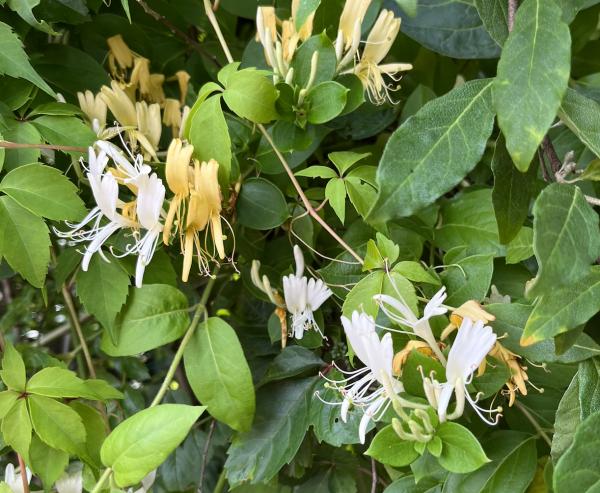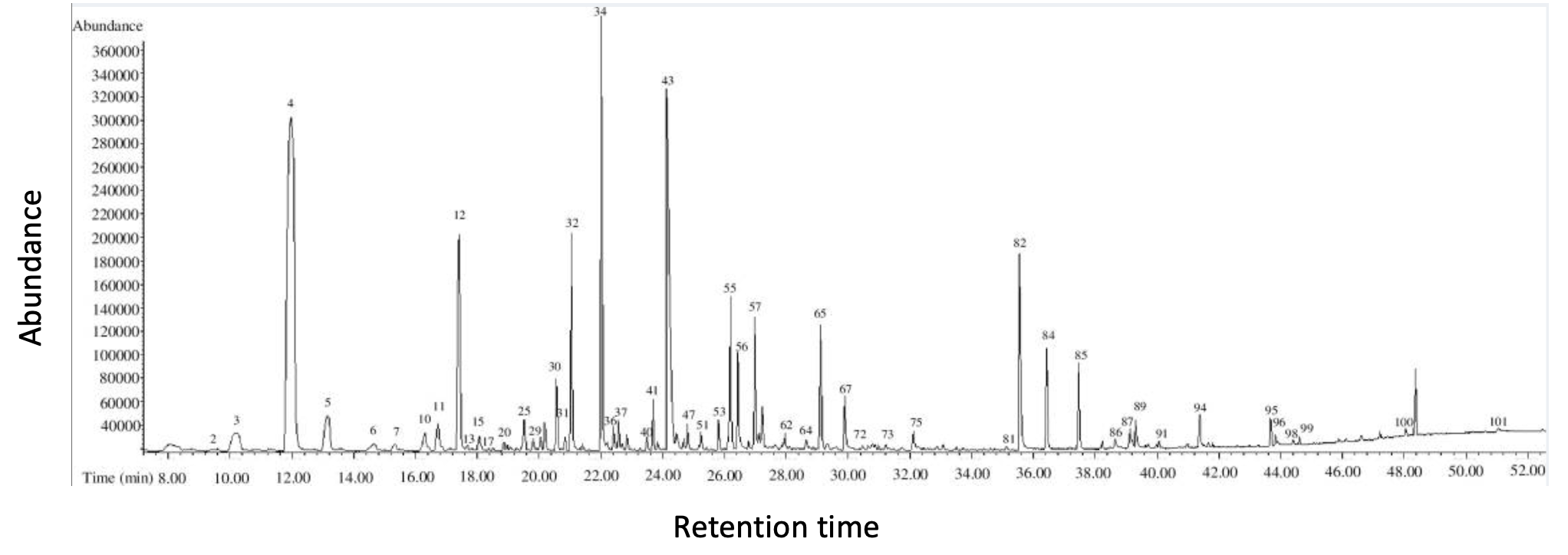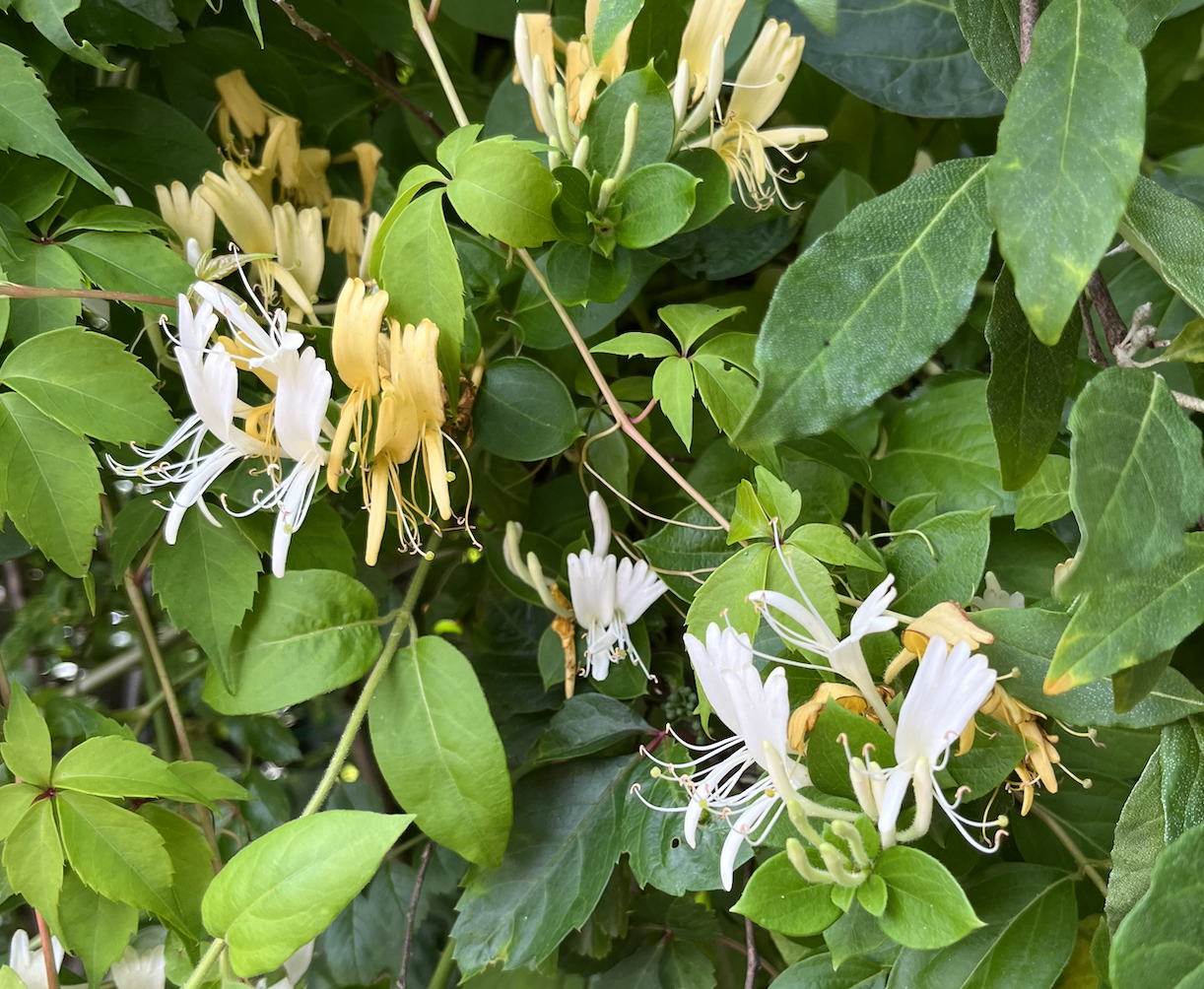
In the Northeast, people with allergies had a miserable spring. The pollen was so fierce that even people who usually have only mild hay fever were walking around moaning while a variety of bio-fluids were spewing out of their noses. Damn trees and flowers!
That's pretty much over, and now a much more pleasant event is getting going – the blossoming of honeysuckle. Perhaps the most recognizable (and arguably most delightful) flower is out in full. I don't know anyone who doesn't enjoy the scent. Make that scents.
As a chemist, I was interested in seeing what concoction of chemicals was responsible for the flower's lovely bouquet. And quite a concoction it is. While many flowers and fruits have a relatively small number of scent chemicals or flavors responsible for their properties, honeysuckle ain't one of them. It's quite a blend. Some components are common to many flowers, but others are less common and can smell quite awful.

Table 1. A gas chromatograph of the 102 key odorants in Lonicera japonica Flos. Each peak represents a different chemical. Source: PLOS ONE. If you're completely out of your gourd, feel free to match each peak with this table, which identifies each chemical.
There are many honeysuckles
There isn't a straightforward answer here because there are 200 known varieties of honeysuckle worldwide and 20 in North America. The authors selected four varieties of the Lonicera family, all from China. How close do these match the composition of American honeysuckle? Very. The species the authors focused on was Lonicera japonica Flos, aka Japanese honeysuckle, which, contrary to its name, is not necessarily in Japan; it is an invasive plant that now flourishes up and down the east coast of the US—including in my backyard.

(Can anyone identify the plant fighting it out with the honeysuckle?)
Japanese honeysuckle has some weird s### in it
In gas chromatography, the most volatile chemicals pass through the column first and will be on the left side of the graph. Table 1 shows the retention time of each chemical on the x-axis. What was the first chemical to come off the column and be identified? Ethanol. I'll drink to that.
Here are some of the more interesting chemicals found, 36 being described as "key odorants," as determined by flavorists. Here are a few of the 36 odorants that were identified:
Peak #4 - 2-butenal, aka crotonaldehyde: Floral. OK, that wasn't terribly informative. A flower smells floral.
Peak #8 - Pyridine: This stuff smells god-awful, something any organic chemist will tell you because we use it routinely, thus eliciting the following response from people in nearby labs:
Who the #### is using pyridine?? (Death stare)
Here are some descriptions of pyridine plucked from the Internet:
- Foul-smelling
- Fishy
- Strong sickening odor
- The smell of pyridine can be described [as] similar to semen
- Sour, smoky, warm, burnt, coffee, putrid, fishy, amine
One of these is actually relevant to your day-to-day activities. Pyridine is found (in small quantities) in coffee. It is formed during the roasting process.
#34 - cis-3-Hexenol: Fresh cut grass
#43 - Acetic acid: This is fine as a 5% solution (vinegar), but if you take a sniff of pure acetic acid, you will wake up in Portugal with no idea how you got there.
#45 - Furfural: Sweet, woody
#55 - Benzaldehyde: Almond oil.
#82 - Hexanoic acid: Sour, cheese, fatty. Low molecular weight carboxylic acids smell awful.
# 90 - β-Ionone: Seaweed, floral. An odd combination, no?
#102 - Vanillin - Vanilla (duh). By the way, the chemical that gives vanilla its flavor is vanillin, whether it is extracted from vanilla beans or made in a factory. There is no difference between the two.
How does this collection of non-floral-smelling chemicals result in the sweet scent of honeysuckle?
It doesn't. I preferentially selected the chemicals that one would not suspect to be found in sweet-smelling honeysuckle. So, what are you smelling when that sweet scent of honeysuckle hits your sinuses? It depends on the species, but for the four species studied, the primary scents included chemicals with the following description:
- horseradish
- fruity
- waxy
- sweet
- vegetable
- caramel
- floral
- rose
- whiskey
- woody
- coconut creamy
- candy
That's quite a variety, no. Perhaps this is why the scent of the honeysuckle flowers is so distinct, and you can smell them before you can see them. They'll be gone soon, so enjoy.



